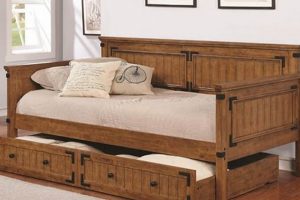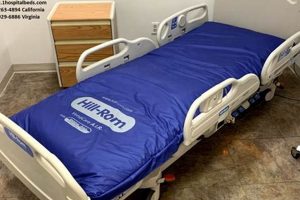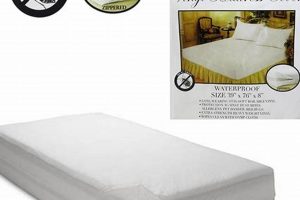The dimensions of a mattress intended for a toddler bed typically measure approximately 28 inches wide by 52 inches long. This standardized sizing facilitates the transition from a crib to a larger sleeping surface while maintaining a safe and appropriately scaled environment for young children. For example, if a parent is purchasing bedding specifically designated for a toddler bed, it is generally designed to fit these measurements.
Utilizing a mattress of the correct size for a toddler bed provides numerous benefits. It ensures a snug and secure fit within the bed frame, minimizing the risk of gaps where a child could become entrapped. Furthermore, the scaled-down dimensions of these mattresses contribute to a sense of security and comfort for toddlers as they adjust to sleeping in a larger bed. Historically, the establishment of standardized dimensions for toddler mattresses has aided in creating a safe and predictable product market for parents.
The subsequent sections will delve into factors to consider when selecting an appropriate mattress for a toddler bed, including material composition, firmness, and safety certifications. Also, compatibility with various toddler bed frames and practical advice for extending the lifespan of such a mattress will be discussed.
Selecting the Correct Mattress Size for a Toddler Bed
The following guidelines outline key considerations when choosing a mattress compatible with a toddler bed frame, emphasizing safety, comfort, and longevity.
Tip 1: Confirm Standard Dimensions. Prior to purchase, verify that the mattress adheres to the standard toddler bed size, approximately 28 inches by 52 inches. This ensures a proper fit within the bed frame, minimizing safety hazards.
Tip 2: Prioritize Firmness. Opt for a firm mattress to provide adequate support for a toddler’s developing spine. Avoid excessively soft mattresses, as they may pose a suffocation risk.
Tip 3: Investigate Material Composition. Examine the materials used in the mattress construction. Seek out options with hypoallergenic properties and those that are free from harmful chemicals, such as phthalates and lead.
Tip 4: Assess Waterproofing Features. Consider a mattress with a waterproof or water-resistant cover. This protects the mattress core from spills and accidents, extending its lifespan and maintaining hygiene.
Tip 5: Evaluate Safety Certifications. Check for certifications from reputable organizations, such as CertiPUR-US or GREENGUARD Gold. These certifications indicate that the mattress has been tested for harmful substances and emissions.
Tip 6: Measure Existing Bed Frame. If you already possess a toddler bed frame, carefully measure the interior dimensions to confirm compatibility with the intended mattress size. Discrepancies can lead to safety issues or discomfort.
Choosing a mattress of the appropriate dimensions is critical for a childs safety, comfort and sleep quality. Selecting a product that adheres to established safety standards and offers adequate support can promote healthy sleep habits during this crucial developmental stage.
The subsequent sections will discuss cleaning and maintenance procedures for toddler mattresses, as well as indicators that a mattress should be replaced to ensure continued safety and hygiene.
1. Standard Dimensions
The phrase “what size mattress is a toddler bed” inherently directs attention to the established standard dimensions governing this specific mattress type. The standard dimensions, typically 28 inches wide by 52 inches long, are not arbitrary; they are a critical component of the definition and functionality of a toddler bed mattress. These dimensions directly influence the safety, comfort, and appropriateness of the mattress within a toddler bed frame. Without adherence to these standard dimensions, a mattress cannot be accurately categorized or used as intended for a toddler bed. For example, a mattress exceeding these dimensions would not fit properly within the frame, potentially creating hazardous gaps, while a smaller mattress would lack the necessary support and safety.
The connection between “what size mattress is a toddler bed” and standard dimensions can be further understood through a cause-and-effect relationship. The need for a safe and appropriately scaled sleeping surface for toddlers necessitates the establishment of standard dimensions. The effect of adhering to these dimensions is a reduction in the risk of entrapment, suffocation, and other potential hazards associated with an improperly sized mattress. Furthermore, standard dimensions facilitate the production and distribution of compatible bedding and accessories, streamlining the consumer experience. If a mattress is not adhered standard, the accessories won’t fit such as bed sheets for the mattress.
In summary, the concept of “what size mattress is a toddler bed” is inextricably linked to the existence and enforcement of standard dimensions. These dimensions are not merely a specification; they are a fundamental requirement for ensuring safety, comfort, and functionality. A thorough understanding of this connection is paramount for parents and caregivers seeking to provide a secure and developmentally appropriate sleep environment for their children. Deviation from these standards carries inherent risks and compromises the intended purpose of the mattress.
2. 28 x 52 Inches
The measurement “28 x 52 inches” constitutes the defining numerical specification in the context of the query “what size mattress is a toddler bed.” This dimensional standard is not arbitrary; rather, it is the established industry norm that dictates the physical parameters of mattresses intended for use in toddler beds. Deviation from these measurements compromises the safety and functionality of the sleep environment.
- Standardized Compatibility
The dimensions of 28 x 52 inches ensure compatibility with the vast majority of toddler bed frames available on the market. This standardization simplifies the purchasing process for consumers, allowing them to confidently select a mattress that will fit securely within a designated frame. A secure fit minimizes the risk of gaps or spaces in which a child could become trapped, thus reducing the potential for injury.
- Optimized Space Utilization
The 28 x 52 inch format represents a compromise between providing adequate sleeping space for a toddler and maintaining a manageable footprint within a nursery or bedroom. These dimensions offer sufficient length and width to accommodate the average toddler’s physical needs while avoiding excessive bulk that could overwhelm a smaller room. The utilization of space in this setting is to have enough room for toddler to sleep without taking too much space in the room.
- Safety Reg
ulation AdherenceMany safety regulations pertaining to toddler beds and mattresses are predicated on the 28 x 52 inch size standard. These regulations address factors such as mattress firmness, material composition, and flame retardancy, all of which are assessed with these dimensions in mind. Adherence to this size standard is often a prerequisite for compliance with applicable safety guidelines and certifications.
- Material Efficiency and Cost Control
The standardized dimensions of 28 x 52 inches facilitate efficient material usage in the manufacturing process. By adhering to a consistent size, manufacturers can minimize waste and optimize production, contributing to cost savings that may be passed on to consumers. This efficiency also allows for more consistent quality control, as production processes are finely tuned to these specific dimensions.
In summation, the measurements of 28 x 52 inches are integral to the understanding of “what size mattress is a toddler bed,” serving as a foundation for compatibility, safety, spatial efficiency, and cost considerations within the industry. These dimensions ensure that any mattress, that meet this standard, meet the safety guidelines, regulations, and also consumer satisfaction.
3. Thickness Variances
Within the context of “what size mattress is a toddler bed,” thickness variances refer to the range of vertical dimensions a mattress can possess while still being considered appropriate for use in a toddler bed frame. Although the length and width are generally standardized at 28 x 52 inches, the thickness can vary, typically ranging from 4 to 6 inches. This variance, though seemingly minor, has significant implications for safety, comfort, and the overall functionality of the sleep environment.
The effect of thickness variances on “what size mattress is a toddler bed” is multifaceted. A mattress that is excessively thick may elevate the sleeping surface to a height that poses a safety risk, increasing the likelihood of a child falling out of bed. Conversely, a mattress that is too thin may not provide adequate support, potentially leading to discomfort or even impacting spinal development. For example, a mattress with a thickness of only 3 inches may bottom out under the weight of a toddler, rendering it ineffective. Parents need to be aware of the safety recommendations, to prevent injuries, and to provide adequate support for the sleeping toddler.
Understanding thickness variances is crucial for several practical reasons. When selecting a mattress, caregivers should consider the height of the toddler bed frame and the child’s physical development. A thicker mattress may be more suitable for older toddlers who are less likely to fall out of bed, while a thinner mattress might be preferable for younger children. Furthermore, caregivers should carefully inspect the fit of the mattress within the frame to ensure there are no excessive gaps, regardless of the mattress’s thickness. While the length and width dimensions are rigid in the definition of “what size mattress is a toddler bed,” the variable thickness should be a key consideration, along with mattress material, safety certification, and the type of bed frame.
4. Frame Compatibility
Frame compatibility is a critical consideration when addressing “what size mattress is a toddler bed.” This refers to the degree to which a mattress conforms to the inner dimensions of a toddler bed frame, ensuring a safe and functional sleep environment for the child. Proper compatibility minimizes risks and maximizes the intended design of the bed.
- Standardized Dimensions and Frame Design
The standard dimensions associated with “what size mattress is a toddler bed,” typically 28 inches by 52 inches, dictate the internal measurements of compatible bed frames. Manufacturers design toddler bed frames with these dimensions in mind, creating a snug fit that prevents gaps. For example, a frame designed for these measurements will not accommodate a crib mattress, which is generally smaller, nor a twin-sized mattress, which is substantially larger. This intentional sizing ensures safety and prevents improper use.
- Gap Minimization and Safety
A primary purpose of frame compatibility is to minimize gaps between the mattress edge and the frame perimeter. Excessive gaps can present a significant safety hazard, as a child could become entrapped, leading to potential injury or suffocation. Proper compatibility ensures that the mattress fits snugly within the frame, reducing the risk of such incidents. Older frames might warp and fail to keep a standard dimension of the frame. A snug fitting mattress ensures the integrity of the mattress and the frame.
- Structural Support and Mattress Longevity
Frame compatibility extends beyond mere dimensional matching; it also involves structural support. A properly fitting mattress receives adequate support from the bed frame, preventing sagging and uneven wear. Conversely, an incompatible mattress may not be fully supported, leading to premature degradation of the mattress materials. Sagging mattresses create discomfort and could pose safety risks. The frame is as important as the mattress in this matter.
- Aesthetic and Functional Integration
Frame compatibility contributes to the overall aesthetic and functional integration of the toddler bed. A mattress that fits seamlessly within the frame creates a visually cohesive unit. Furthermore, proper integration ensures that safety features, such as side rails or guardrails, function as intended. A poorly fitting mattress might obstruct these features, negating their effectiveness and compromising the child’s safety.
In conclusion, frame compatibility is an integral aspect of “what size mattress is a toddler bed.” Ensuring that a mattress adheres to the standardized dimensions and fits securely within the bed frame is crucial for safety, structural integrity, and functional design. Prioritizing frame compatibility minimizes risks and promotes a secure and comfortable sleep environment for the child. Deviation from this compatibility can have long-term effects.
5. Proper Fit
The concept of “Proper Fit” is inextricably linked to “what size mattress is a toddler bed,” functioning as a critical determinant of the mattress’s suitability and safety. Proper fit, in this context, denotes the extent to which a mattress precisely occupies the space within a toddler bed frame, leaving minimal or no gaps between the mattress edges and the surrounding frame. It is not merely a matter of aesthetics, but a primary safety consideration that directly affects the child’s well-being.
A “Proper Fit” is crucial for several reasons. The inverse, an improper fit, presents significant risks. For example, if a mattress is too small, gaps can form between the mattress and the frame, creating a potential entrapment hazard for a child’s limbs or head. Real-life incidents have demonstrated the tragic consequences of such gaps, underscoring the critical need for a mattress that conforms precisely to the frame’s dimensions. Conversely, a mattress that is too large may not fit secu
rely within the frame, leading to instability and potential structural damage to the bed. The practical significance of understanding this connection lies in the proactive steps caregivers must take to ensure the mattress selected is specifically designed for and compatible with their toddler bed frame. It has long-term benefits and is a necessary step.
In summary, the phrase “what size mattress is a toddler bed” implies the essential requirement of a “Proper Fit.” This fit is not simply a desirable attribute but a fundamental safety imperative. Caregivers must prioritize accurate measurements and adherence to standard dimensions when selecting a mattress to mitigate risks and ensure a secure sleeping environment. Challenges may arise from variations in frame manufacturing or inconsistencies in mattress sizing, requiring diligence in verifying compatibility. By understanding and acting upon this connection, potential safety hazards can be effectively minimized, contributing to a child’s well-being and restful sleep.
6. Safety Standards
Safety standards play a crucial role in defining and regulating “what size mattress is a toddler bed,” ensuring that products intended for young children meet specific criteria to minimize potential hazards. These standards address various aspects of mattress design, materials, and construction, all aimed at providing a secure sleep environment.
- Flame Retardancy Regulations
Federal and state regulations mandate that mattresses, including those for toddler beds, meet specific flame retardancy standards. These standards, such as those outlined in 16 CFR Part 1633, aim to reduce the risk of fire-related injuries by slowing the spread of flames. Mattresses must undergo rigorous testing to demonstrate compliance, often involving the use of flame-resistant materials or chemical treatments. Failure to meet these standards can result in legal penalties and product recalls.
- Material Composition and Chemical Emissions
Safety standards also govern the materials used in mattress construction, limiting or prohibiting the presence of harmful chemicals such as phthalates, lead, and formaldehyde. Certifications like CertiPUR-US indicate that a mattress has been independently tested and verified to be free from certain hazardous substances and to have low volatile organic compound (VOC) emissions. Adherence to these material standards minimizes the risk of allergic reactions, respiratory problems, and other health concerns for toddlers.
- Structural Integrity and Durability
Safety standards address the structural integrity and durability of toddler bed mattresses, ensuring that they can withstand regular use and maintain their shape and support over time. Testing protocols may involve assessing compression resistance, edge support, and seam strength to prevent sagging, indentations, or other forms of degradation that could compromise the safety and comfort of the sleeping child. Strong structural integrity is a part of the entire bed frame itself.
- Size and Fit Specifications
As previously discussed, size and fit are paramount considerations in toddler bed mattress safety. Standards dictate the allowable tolerances for mattress dimensions to ensure a snug and secure fit within the bed frame. Excessive gaps between the mattress and the frame can create entrapment hazards, leading to potential injuries. Therefore, manufacturers must adhere to strict size specifications to minimize this risk and comply with relevant safety guidelines. Size is important to the structure of the mattress and bed integrity.
In conclusion, safety standards are integral to understanding “what size mattress is a toddler bed.” These standards encompass a range of regulations and guidelines pertaining to flame retardancy, material composition, structural integrity, and size specifications, all working in concert to minimize potential hazards and ensure a safe sleep environment for toddlers. Compliance with these standards is not merely a legal obligation but a moral imperative for manufacturers and retailers.
7. Weight Considerations
Weight considerations are intrinsically linked to the query “what size mattress is a toddler bed,” impacting both the structural integrity of the bed frame and the overall safety and comfort of the child. The mass of the mattress, relative to the bed frame’s design and material composition, is a crucial factor in ensuring stability and preventing potential hazards.
- Frame Load Capacity
Toddler bed frames are designed with a specific load capacity, representing the maximum weight they can safely support. Exceeding this limit, particularly with a heavier-than-recommended mattress, can compromise the frame’s structural integrity, leading to warping, cracking, or even complete collapse. Real-world examples include instances where parents have used adult-sized mattresses on toddler beds, resulting in frame failure and potential injury to the child. Exceeding the weight limit on the toddler bed could also void product warranty.
- Mattress Support and Longevity
The weight of the child, combined with the mattress’s own mass, directly influences the degree of support provided. An excessively heavy mattress may overwhelm the frame’s support system, causing the mattress to sag prematurely. This sagging not only diminishes comfort but also alters the child’s spinal alignment, potentially leading to discomfort or developmental issues. It’s important for the toddler to have the required support for proper sleep and development. An unstable surface leads to poor sleep habits.
- Ease of Handling and Maintenance
The weight of the mattress affects its ease of handling during routine tasks such as changing sheets, rotating the mattress, or cleaning the bed frame. A heavier mattress requires greater effort and increases the risk of accidental injury to the caregiver. Lightweight mattresses will allow the caregivers to perform maintenance with less risk of injury to themselves. The caregiver can also monitor for damage of frame and mattress more easily.
- Center of Gravity and Stability
The combined weight of the mattress and child influences the bed’s center of gravity and overall stability. A heavier mattress raises the center of gravity, making the bed more susceptible to tipping, especially if the child is active or the bed is placed on an uneven surface. The weight must be balanced between frame and mattress for safety and stability.
In conclusion, weight considerations are an essential aspect of “what size mattress is a toddler bed.” A balanced approach, taking into account the frame’s load capacity, the mattress’s support characteristics, and the ease of handling, is crucial for ensuring a safe, comfortable, and durable sleep environment for the child.
Frequently Asked Questions
The following questions address common inquiries regarding toddler bed mattress sizing, material composition, and safety regulations, providing clear and concise information for caregivers.
Question 1: What are the standard dimensions for a toddler bed mattress?
The industry-standard dimensions for a toddler bed mattress are approximately 28 inches in width and 52 inches in length. These dimensions ensure compatibility
with most toddler bed frames currently available on the market.
Question 2: Is it acceptable to use a crib mattress in a toddler bed?
Generally, no. While crib mattresses may appear similar in size, subtle dimensional differences can lead to an improper fit within a toddler bed frame, creating potential safety hazards. The standard sizes for cribs and toddler beds are different.
Question 3: What is the recommended mattress thickness for a toddler bed?
While length and width are standardized, thickness can vary. A thickness between 4 and 6 inches is generally recommended, balancing support and safety. Mattresses exceeding this thickness may increase the risk of falls. Safety regulations should always be followed. A proper thickness leads to better support and quality of sleep.
Question 4: Are there specific safety certifications to look for when purchasing a toddler bed mattress?
Certifications such as CertiPUR-US and GREENGUARD Gold indicate that a mattress has been tested for harmful chemicals and emissions. Seeking mattresses with these certifications helps ensure a safer sleep environment for the child.
Question 5: How frequently should a toddler bed mattress be replaced?
The lifespan of a toddler bed mattress depends on its quality and usage. However, if the mattress shows signs of wear, such as sagging or indentations, or if it has been subjected to significant spills or accidents, replacement is advisable. Mattresses usually last for approximately 5 years with normal use.
Question 6: Do all toddler bed frames adhere to the same size standards?
While most toddler bed frames are designed to accommodate a standard 28 x 52-inch mattress, slight variations may exist. It is crucial to measure the interior dimensions of the bed frame before purchasing a mattress to ensure a proper and secure fit. Measure twice, purchase once. This will ensure the compatibility of the mattress and frame.
Understanding these essential factors contributes to a safer and more comfortable sleep experience for toddlers. Ensuring that the correct dimensions and safety standards are met is the best practice to consider.
The following section will explore the effects of sleep deprivation on toddlers’ well-being and behavior.
Conclusion
The preceding discussion has thoroughly examined “what size mattress is a toddler bed,” emphasizing the standardized dimensions, safety implications, and practical considerations essential for informed decision-making. Adherence to the established measurements of 28 inches by 52 inches is paramount, ensuring frame compatibility, minimizing entrapment hazards, and promoting a stable and supportive sleep surface. Factors such as thickness variance, material composition, and weight limits must also be carefully evaluated to optimize safety and longevity.
Given the crucial role of adequate sleep in a child’s development, selecting an appropriately sized and certified toddler bed mattress transcends mere convenience. It is a direct investment in the child’s well-being, influencing physical health, cognitive function, and emotional stability. Caregivers must prioritize these considerations, recognizing that a properly chosen mattress contributes significantly to a safe and restful sleep environment, setting the foundation for healthy growth and development in the years ahead. Continued awareness and adherence to safety standards in this domain are essential.







![Find The Best Rollaway Bed Mattress Replacement [Guide] Organic & Natural Mattress Buyer’s Guide: Non-Toxic Sleep Solutions Find The Best Rollaway Bed Mattress Replacement [Guide] | Organic & Natural Mattress Buyer’s Guide: Non-Toxic Sleep Solutions](https://mattressworldpa.com/wp-content/uploads/2025/07/th-7028-300x200.jpg)